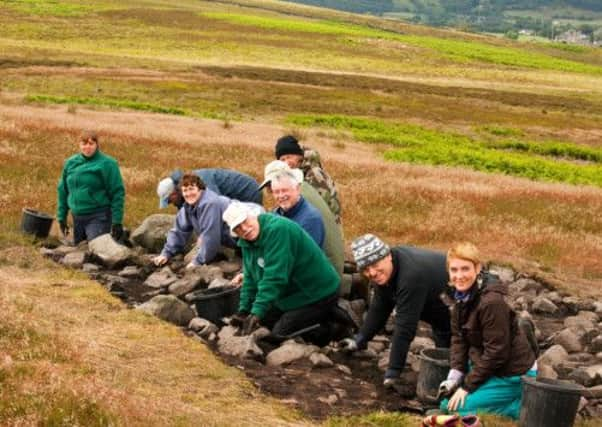Volunteers throw new light on prehistoric moors life


Examples of prehistoric rock art offered a tantalising hint of what its contours may contain.
But evidence of life, possibly dating back 9,000 years, on Stanbury Hill on the edge of Bingley Moor, has been unearthed thanks to a community archaeology project investigating the site.
Advertisement
Hide AdAdvertisement
Hide AdSet up in 2008 and run and staffed by local volunteers, the Stanbury Hill Project was tasked with probing the prehistoric landscape which was characterised by “cup and ring marked” rocks – believed to date from the late Neolithic to early Bronze Age, around 2500 BC.
As it draws to an end, project director Keith Boughey revealed that excavation has uncovered chert tools, made from a flint-like material, which could date from the Mesolithic period (or Middle Stone Age).
The discovery of the tools means that hunter-gatherers were on the site 9,000 years ago, around 7000 BC.
Dr Boughey, a retired teacher, said: “That we did not expect. It did not mean they lived up there but they were certainly there. We found clear evidence that human beings were on the hill in 7000 BC.”
Advertisement
Hide AdAdvertisement
Hide AdThe project also shed new light on what life would have been like on the hill during the Bronze Age.
Dr Boughey said: “What we might have had up here on the hill is people hunting, making and using tools, growing their crops and tending their animals, in a clearing surrounded by woodland and in a climate warmer and drier than today, living and, according to one of the many theories about prehistoric rock art, possibly performing acts of worship to honour their ancestors – all starting as long as 9,000 years ago.”
Following research that included the use of magnetism, electrical resistance and metal detecting to probe for remains under the ground, an area of just under 50,000 square metres of moorland revealed more than 200 different features.
Excavation recovered charcoal, flint and chert tools, evidence of some form of agriculture, and several new examples of rock art.
Advertisement
Hide AdAdvertisement
Hide AdThe charcoal originated from a mixture of tree species that suggested a date range of 1850-3350 BC and a deciduous woodland environment in a warmer climate than today, while radiocarbon dates from the western end of the site in the area of the excavations returned dates of 1905-1755 and 2035-1895 BC, firmly in the Bronze Age.
Dr Boughey said: “The key thing is getting some dates. Those two dates coincide with the human evidence up there. We definitely have a prehistoric site up there; it is Bronze Age; 4,000 years ago there were people up there doing stuff.”
As well as finding tools made of chert which is found locally, researchers found tools made of flint which had come from the Yorkshire Wolds, more than 100 miles away.
“Flint was more important than oil is to us today,” said Dr Boughey. “It may have been carried with horses, we do not know. There is clear evidence that some kind of trading was going on.”
Advertisement
Hide AdAdvertisement
Hide AdThe researchers also discovered fresh examples of the prehistoric rock art on the site.
“They are a mystery,” said Dr Boughey. “There are lots of theories about what they meant. One theory is that the rock art was from people maybe worshipping the ancestors. We found evidence that the rock art on the site was all brought there especially to be carved. We know that where they are now is special, it was not just a random thing.”
The project was a joint venture between the Bingley and District Local History Society and the Division of Archaeological, Geographical and Environmental Sciences at the University of Bradford and funded by a grant of just under £50,000 from the Heritage Lottery Fund.
A team of up to 40 volunteers aged from 17 to people in their 70s were involved in surveying, excavation work and analysis.
Advertisement
Hide AdAdvertisement
Hide Ad“The archaeology was amazing enough but equally was the enthusiasm and involvement of local people,” said Dr Boughey. “This gave them an opportunity for the first time to come along and get involved and pick up a whole pile of skills.”
People can learn more about the project, and its findings at an afternoon of archaeological events and presentations at Eldwick Memorial Hall on April 27 from 1.30pm.
A book and booklet have been published on the work.